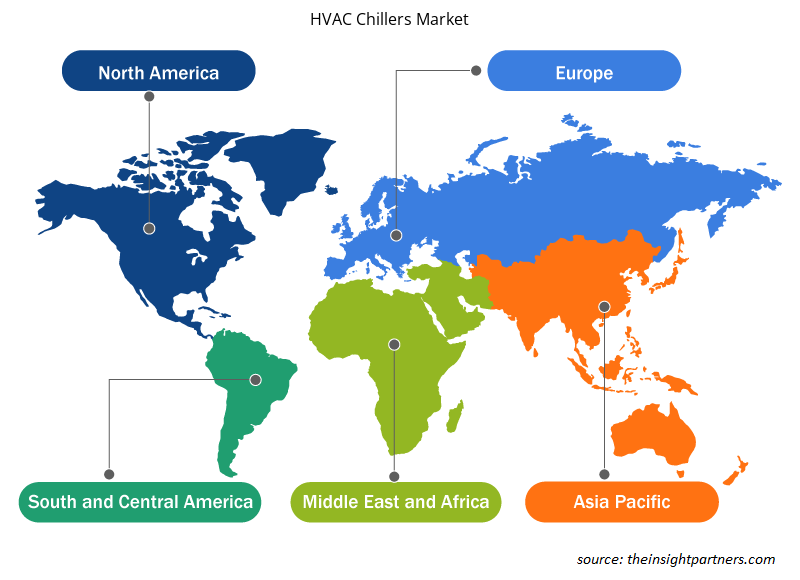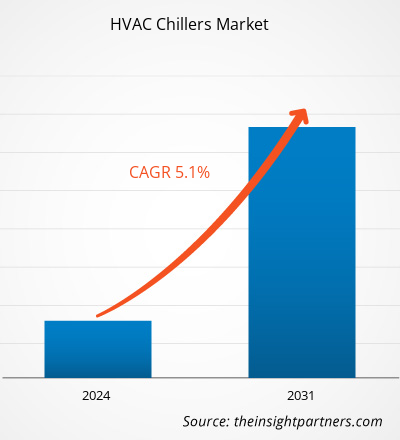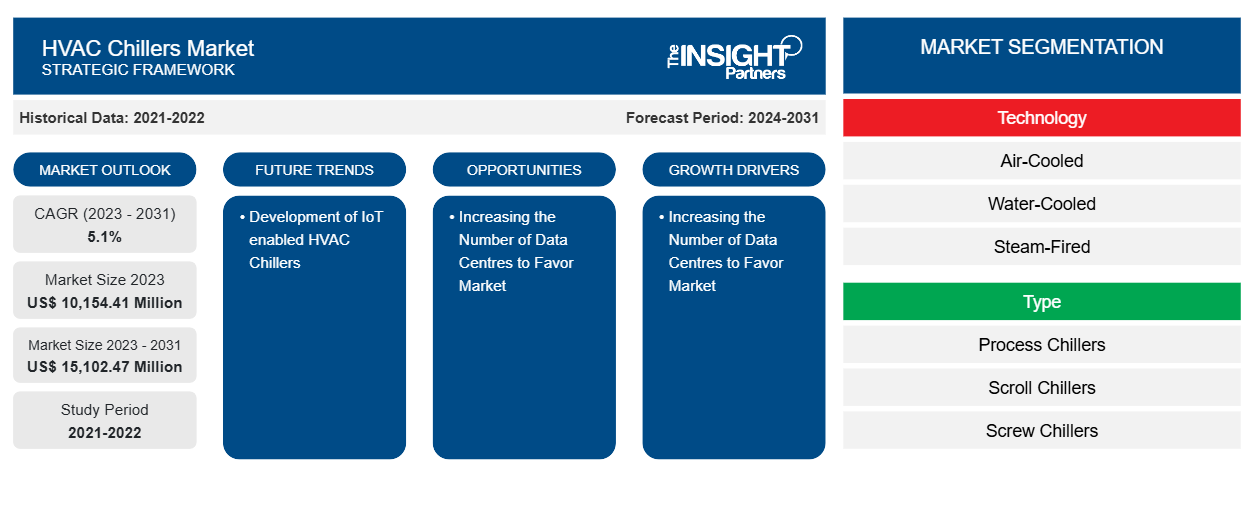Si prevede che la dimensione del mercato dei refrigeratori HVAC raggiungerà i 15.102,47 milioni di dollari entro il 2031, rispetto ai 10.154,41 milioni di dollari del 2023. Si prevede che il mercato registrerà un CAGR del 5,1% nel periodo 2023-2031. Le prospettive economiche dinamiche e promettenti nei paesi in via di sviluppo e il progresso tecnologico in vari paesi asiatici rimarranno probabilmente una tendenza chiave nel mercato.
Analisi di mercato dei refrigeratori HVAC
L'aumento della domanda di case intelligenti, la crescente industrializzazione e urbanizzazione stanno rafforzando la domanda di refrigeratori HVAC in tutto il mondo. Inoltre, la crescente attenzione alla costruzione di grattacieli in Cina e Giappone ha aumentato la consapevolezza sui sistemi raffreddati ad acqua refrigerata e sta offrendo nuove opportunità per guidare la domanda di refrigeratori HVAC a livello globale. Condizioni meteorologiche estreme, aumento della popolazione, crescita di progetti infrastrutturali e di sviluppo urbano e crescenti preoccupazioni in materia di assistenza sanitaria sono alcuni dei fattori chiave che costringeranno gli operatori globali a investire nel settore del riscaldamento, della ventilazione e dell'aria condizionata. Inoltre, si prevede che l'industria edile in crescita, insieme ad hotel e ristoranti, contribuirà alla crescita del mercato dei refrigeratori HVAC .
Panoramica del mercato dei refrigeratori HVAC
I principali stakeholder nell'ecosistema del mercato globale dei refrigeratori HVAC includono fornitori di materie prime, produttori di refrigeratori HVAC e utenti finali. Il fornitore di materie prime è uno stakeholder cruciale nell'ecosistema del mercato dei refrigeratori HVAC . Le principali materie prime sono silicio, acciaio inossidabile, ibrido e altri materiali utilizzati principalmente per la fabbricazione dei refrigeratori HVAC . I principali fornitori di materie prime includono ASTM International, National Bearings, Kineco Limited, Morgan Advanced Materials, ecc. ASTM International, che è un fornitore di materie prime per cuscinetti, ha annunciato sette nuovi progetti sponsorizzati Research to Standards (R2S) per assistere l'Additive Manufacturing Center of Excellence (AM CoE ) di ASTM e il suo obiettivo di accelerare la standardizzazione AM e l'adozione del settore. Di conseguenza, le maggiori attività dei fornitori di materie prime stanno migliorando la produzione di refrigeratori HVAC , alimentando la crescita del mercato.
Personalizza questo report in base alle tue esigenze
Riceverai la personalizzazione gratuita di qualsiasi report, comprese parti di questo report, o analisi a livello nazionale, pacchetto dati Excel, oltre a usufruire di grandi offerte e sconti per start-up e università
-
Scopri le principali tendenze di mercato in questo rapporto.Questo campione GRATUITO includerà analisi di dati che spaziano dalle tendenze di mercato alle stime e alle previsioni.
Driver e opportunità del mercato dei refrigeratori HVAC
Aumentare il numero di data center per favorire il mercato
Il crescente sviluppo urbano e la proliferazione di tecnologie avanzate, insieme all'aumento della popolazione, hanno portato a un'elevata domanda e consumo di energia, a causa dei quali si registra un aumento dei refrigeratori HVAC a risparmio energetico a livello globale. Inoltre, si registra un aumento nell'installazione di refrigeratori HVAC poiché le nuove tecnologie HVAC utilizzano l'intelligenza artificiale per massimizzare la produttività. Si prevede che l'aumento del numero di data center guiderà la crescita del mercato dei refrigeratori nel prossimo futuro in tutto il mondo. I data center necessitano di molta energia e il principale motore del lavoro degli ingegneri di progettazione dei data center è quello di offrire sistemi HVAC affidabili, a risparmio energetico e convenienti , che stanno agendo come un importante motore per il mercato.
Crescita economica nei paesi in via di sviluppo nel mondo
Prospettive economiche positive nei paesi in via di sviluppo come Cina e Giappone, che consentono lo sviluppo del mercato dei refrigeratori HVAC . Il mercato dei refrigeratori HVAC sta crescendo a causa di progetti di costruzione commerciale insieme a un numero crescente di centri commerciali e negozi al dettaglio. L'elevato tenore di vita e l'aumento della spesa sanitaria aumentano la domanda di refrigeratori HVAC nelle nazioni sviluppate. Inoltre, si prevede che la crescente domanda di unità di raffreddamento di piccola e media potenza nell'Europa meridionale stimolerà la domanda di prodotti nella regione, che dovrebbe anche guidare la crescita del mercato dei refrigeratori HVAC a livello globale nei prossimi anni.
Analisi della segmentazione del rapporto di mercato dei refrigeratori HVAC
I segmenti chiave che hanno contribuito alla derivazione dell'analisi di mercato dei refrigeratori HVAC sono la tecnologia, la tipologia e l'applicazione.
- In base alla tecnologia, il mercato dei refrigeratori HVAC è suddiviso in raffreddati ad aria, raffreddati ad acqua e alimentati a vapore. Il segmento raffreddato ad aria ha detenuto una quota di mercato maggiore nel 2023.
- In base al tipo, il mercato dei refrigeratori HVAC è suddiviso in refrigeratori di processo, refrigeratori scroll, refrigeratori a vite , refrigeratori centrifughi e refrigeratori ad assorbimento. Il segmento dei refrigeratori a vite ha detenuto una quota di mercato maggiore nel 2023.
- In base all'applicazione, il mercato dei refrigeratori HVAC è suddiviso in commerciale, industriale e residenziale. Il segmento industriale ha detenuto una quota di mercato maggiore nel 2023.
Analisi della quota di mercato dei refrigeratori HVAC per area geografica
L'ambito geografico del rapporto sul mercato dei refrigeratori HVAC è suddiviso principalmente in cinque regioni: Nord America, Asia Pacifico, Europa, Medio Oriente e Africa, e Sud e Centro America.
L'Asia Pacifica è leader del mercato. Gli sforzi del governo nell'area Asia Pacifica, come le iniziative "Make in India" e "Make in China" per migliorare il settore manifatturiero del paese, andrebbero a vantaggio anche dell'industria dei refrigeratori HVAC. Il crescente sviluppo nei settori manifatturiero, minerario e aerospaziale sta guidando la domanda per il mercato dei refrigeratori HVAC nella regione Asia Pacifica.
Approfondimenti regionali sul mercato dei refrigeratori HVAC
Le tendenze regionali e i fattori che influenzano il mercato dei refrigeratori HVAC durante il periodo di previsione sono stati ampiamente spiegati dagli analisti di Insight Partners. Questa sezione discute anche i segmenti e la geografia del mercato dei refrigeratori HVAC in Nord America, Europa, Asia Pacifico, Medio Oriente e Africa e America meridionale e centrale.

- Ottieni i dati specifici regionali per il mercato dei refrigeratori HVAC
Ambito del rapporto di mercato sui refrigeratori HVAC
| Attributo del report | Dettagli |
|---|---|
| Dimensioni del mercato nel 2023 | 10.154,41 milioni di dollari USA |
| Dimensioni del mercato entro il 2031 | 15.102,47 milioni di dollari USA |
| CAGR globale (2023-2031) | 5,1% |
| Dati storici | 2021-2022 |
| Periodo di previsione | 2024-2031 |
| Segmenti coperti |
Per tecnologia
|
| Regioni e Paesi coperti |
America del Nord
|
| Leader di mercato e profili aziendali chiave |
|
Densità degli attori del mercato: comprendere il suo impatto sulle dinamiche aziendali
Il mercato dei refrigeratori HVAC sta crescendo rapidamente, spinto dalla crescente domanda degli utenti finali dovuta a fattori quali l'evoluzione delle preferenze dei consumatori, i progressi tecnologici e una maggiore consapevolezza dei vantaggi del prodotto. Con l'aumento della domanda, le aziende stanno ampliando le loro offerte, innovando per soddisfare le esigenze dei consumatori e capitalizzando sulle tendenze emergenti, il che alimenta ulteriormente la crescita del mercato.
La densità degli operatori di mercato si riferisce alla distribuzione di aziende o società che operano in un particolare mercato o settore. Indica quanti concorrenti (operatori di mercato) sono presenti in un dato spazio di mercato in relazione alle sue dimensioni o al valore di mercato totale.
Le principali aziende che operano nel mercato dei refrigeratori HVAC sono:
- Elettronica LG
- Mitsubishi Electric Corporation
- Società globale di trasporto
- DAIKIN INDUSTRIES, Ltd.
- Assistenza termica, Inc.
- Trane
Disclaimer : le aziende elencate sopra non sono classificate secondo un ordine particolare.

- Ottieni una panoramica dei principali attori del mercato dei refrigeratori HVAC
Notizie di mercato e sviluppi recenti sui refrigeratori HVAC
Il mercato dei refrigeratori HVAC viene valutato raccogliendo dati qualitativi e quantitativi dopo la ricerca primaria e secondaria, che include importanti pubblicazioni aziendali, dati associativi e database. Di seguito sono elencati alcuni degli sviluppi nel mercato dei refrigeratori HVAC:
- Airedale International Air Conditioning Ltd. ha annunciato il lancio di un nuovo stabilimento produttivo in Virginia, USA. Il nuovo stabilimento produrrà soluzioni di raffreddamento per cogliere le opportunità nel crescente settore dei data center. (Fonte: Airedale International Air Conditioning Ltd, comunicato stampa, novembre 2022)
- LG Air Conditioning Technologies USA ha lanciato LG Inverter Scroll Heat Pump Chiller (ISHPC). (Fonte: LG Air Conditioning Technologies, comunicato stampa, gennaio 2022)
Copertura e risultati del rapporto sul mercato dei refrigeratori HVAC
Il rapporto "Dimensioni e previsioni del mercato dei refrigeratori HVAC (2021-2031)" fornisce un'analisi dettagliata del mercato che copre le seguenti aree:
- Dimensioni e previsioni del mercato dei refrigeratori HVAC a livello globale, regionale e nazionale per tutti i principali segmenti di mercato coperti dall'ambito
- Tendenze del mercato dei refrigeratori HVAC e dinamiche di mercato come driver, vincoli e opportunità chiave
- Analisi PEST e SWOT dettagliate
- Analisi di mercato dei refrigeratori HVAC che copre le principali tendenze del mercato, il quadro globale e regionale, i principali attori, le normative e i recenti sviluppi del mercato
- Analisi del panorama industriale e della concorrenza che copre la concentrazione del mercato, l'analisi della mappa termica, i principali attori e gli sviluppi recenti per il mercato dei refrigeratori HVAC
- Profili aziendali dettagliati
- Analisi storica (2 anni), anno base, previsione (7 anni) con CAGR
- Analisi PEST e SWOT
- Valore/volume delle dimensioni del mercato - Globale, Regionale, Nazionale
- Industria e panorama competitivo
- Set di dati Excel
Report recenti
Testimonianze
Motivo dell'acquisto
- Processo decisionale informato
- Comprensione delle dinamiche di mercato
- Analisi competitiva
- Analisi dei clienti
- Previsioni di mercato
- Mitigazione del rischio
- Pianificazione strategica
- Giustificazione degli investimenti
- Identificazione dei mercati emergenti
- Miglioramento delle strategie di marketing
- Aumento dell'efficienza operativa
- Allineamento alle tendenze normative























 Ottieni un campione gratuito per - Mercato dei refrigeratori HVAC
Ottieni un campione gratuito per - Mercato dei refrigeratori HVAC